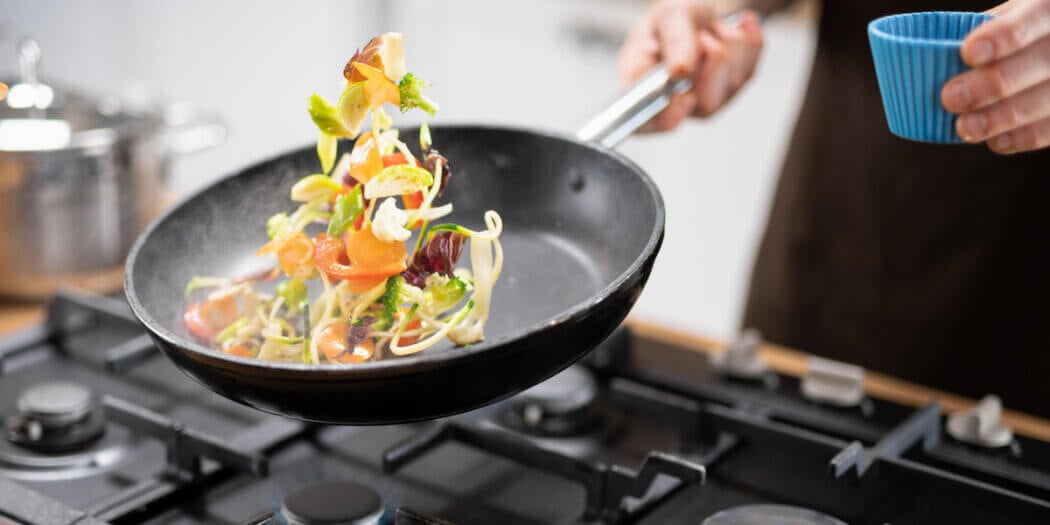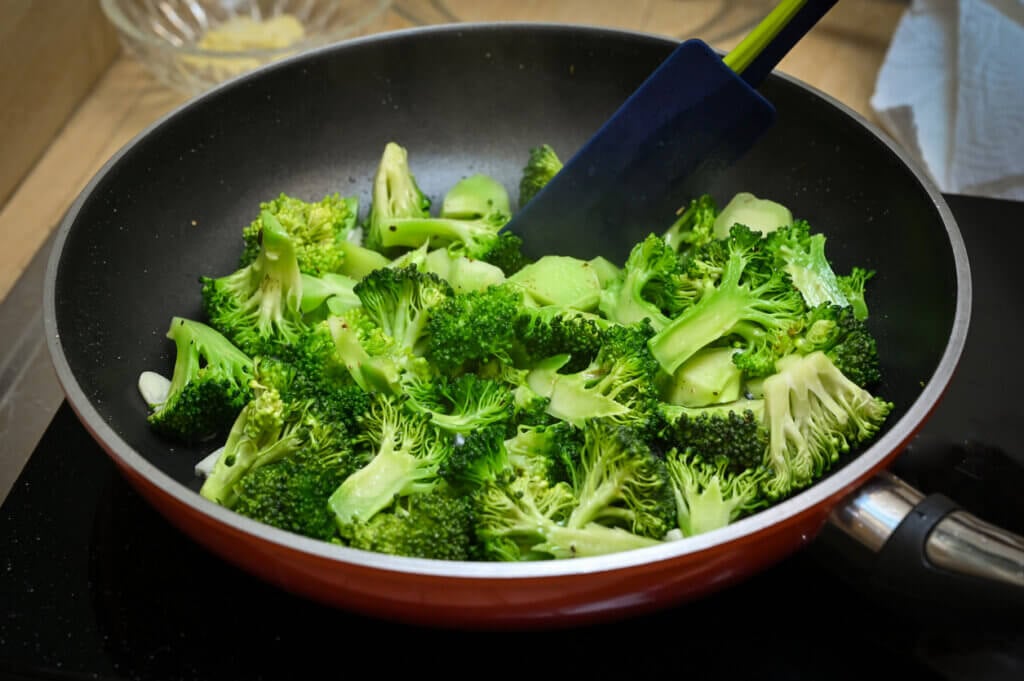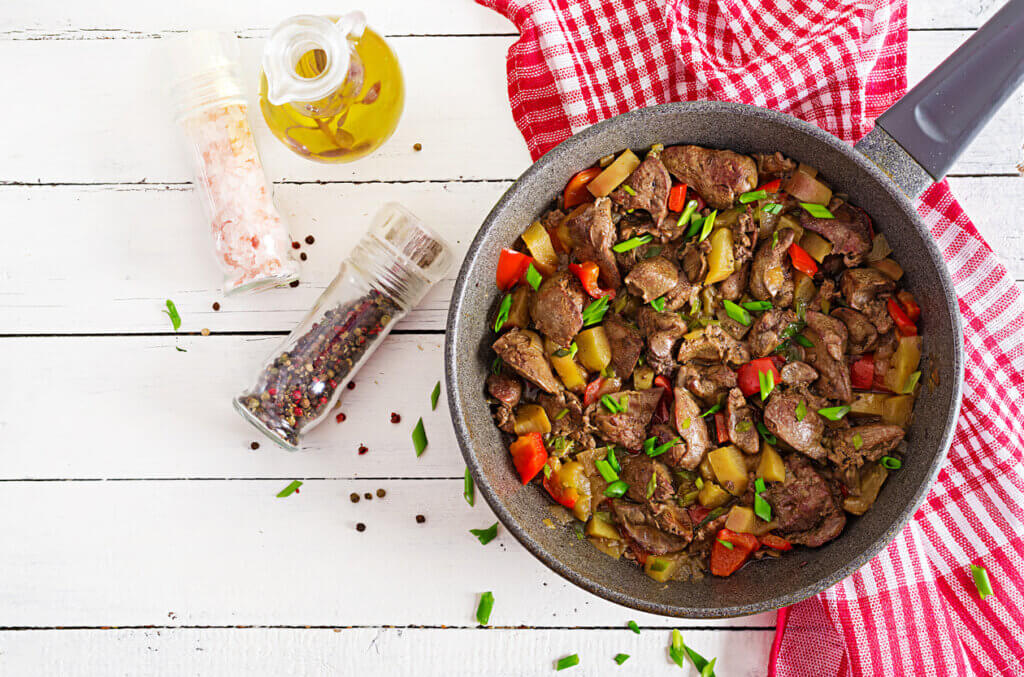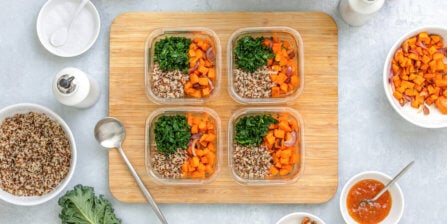Planning & Prep
How to Sauté Vegetables and Meat in 5 Easy Steps

What does sauté mean?
The word sauté is derived from the French root sauter, meaning “to jump”, and is used to describe how food “jumps” in the saucepan while being cooked. To sauté meats or vegetables, cook them in a pan over high heat while using a spatula or quick wrist movement to toss the food around the pan.
If you’re a beginner, try sautéing with a spatula first. This way you’ll get a feel for the process before adding in the wrist movement for efficiency and style points. To practice the wrist technique away from the stove, use dried beans and try the movement over the kitchen sink for easy clean-up.
Sauté pans
Sauté pans have a large round base with low sides that give the pan as much surface area as possible for browning meats and vegetables. Pans can be found in a variety of metals including cast iron, aluminum, and stainless steel, and some come with a lid.
You can use a frying pan as long as there is enough space for the amount of food you’re sautéing. Keep in mind that it’s better to sauté a dish in two batches rather than overcrowd the pan. Also, the sides of frying pans are lower than the sides of saute pans, so stir the food carefully so that you don’t end up with food all over the stovetop.
What oils are best for sautéing?
Since sautéing involves high heat, you should use oils that have a high smoke point. Oils and fats like clarified butter, ghee, rendered lard, duck fat, canola oil, sunflower oil, and rapeseed oil are great for sautéing! However, ingredients like olive oil shouldn’t be used for sautéing due to a low smoke point, but some chefs enjoy drizzling it over sautéed vegetables with a pinch of salt for extra flavor.
How to sauté
Sautéing is easy once you’ve mastered the steps. Here’s a step-by-step guide on how to sauté to perfection.

1. Prepare your ingredients
The first step is peeling and washing the vegetables that you will cook. Once they’re clean, pat them dry with a paper or kitchen towel and place them on a cutting board. Use a sharp knife to carefully cut the food into similar-sized pieces, allowing them to cook evenly.
2. Bring ingredients to room temperature
For the best results, food should not be cold when you saute it. Allow any refrigerated foods to come to room temperature. This may take between 15 minutes and an hour depending on the food and how cold it was.
3. Heat the sauté pan
Heat your pan. To check if your pan is hot enough, place a drop of water in the pan. Once the water sizzles and evaporates within seconds, the pan is ready to go.
4. Add oil
Only add enough cooking oil to create a thin layer on the bottom of the pan. Always err on the side of too little because you can add more if necessary. When working with a recipe, use the amount suggested for the best results.
5. Toss the ingredients
So it cooks evenly, add the food in a single layer on the bottom of the pan.
5. Stir
Keep the fire on high and stir frequently. You want the pieces of veggies or meat to brown evenly. This process takes just a couple of minutes. Use a flat-bottomed wood or metal spatula to move the food around, or try flipping the food in the pan if you’re feeling confident.
Sautéing vegetables
When sautéing fresh vegetables, the most important step to remember is to cut the pieces evenly. Sauté one kind of vegetable at a time, unless you’re cooking different types of the same type of vegetable, such as yellow and red bell peppers. Remember not to add water to the pan or cover it with a lid, this will create too much moisture and make the veggies mushy.
Sautéing meat
Similar to vegetables, meat needs to be cut into small, even pieces (if you’re not sauteing the whole cut of meat in one go). You only need to use one to three teaspoons of oil or fat, less is more. Cook until the meat reaches the proper internal temperature:
- Chicken: 165 °F
- Steak: 145 °F
- Pork chops: 145 °F
- Veal Chops: 145 °F
- Lamb: 160 °F

After the meat is done cooking, cover it with a folded piece of foil, like a tent, and let it rest for three to five minutes. You can use the pan drippings to make a pan sauce gravy to serve over the meat or a side of mashed potatoes.
Shop for your sautéing needs online
Sautéing is a quick and easy way to prepare delicious, healthy meals for your family. With Instacart, get everything you need delivered to your front door. Just fill your cart and choose same-day delivery at check out or schedule your delivery in advance! Less time running errands means more time with loved ones.
Most Recent in Planning & Prep

Planning & Prep
Average Grocery Cost per Month: The 2025 Breakdown
The average grocery cost per month, per person, in the United States is roughly $350 for adults between 19 and 50 years old in a four-person household. This estimation depends on multiple factors, such as…
Dec 23, 2024
Planning & Prep
33 Shocking Global and National Food Waste Statistics (2025)
Did you know nearly 30% of the food produced globally is never eaten? This staggering food waste statistic highlights the alarming issue of uneaten food — a problem with environmental, economic and social consequences. Food…
Dec 23, 2024
Planning & Prep
12 Best Substitutes for Eggs in Baking
Ever run out of eggs mid-recipe or need a quick swap for dietary reasons? Don’t let an empty egg carton or a food sensitivity stop you from enjoying delicious baked treats! There are tons of…
Dec 19, 2024

 17 Grocery List Categories to Make Shopping Easy
17 Grocery List Categories to Make Shopping Easy  How to Meal Plan: Step-by-Step Guide to Meal Planning
How to Meal Plan: Step-by-Step Guide to Meal Planning  How To Read Food Labels: Guide to Nutrition Labels
How To Read Food Labels: Guide to Nutrition Labels 

